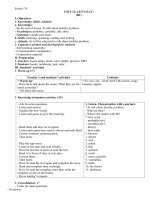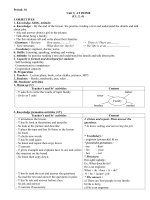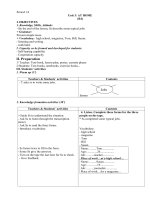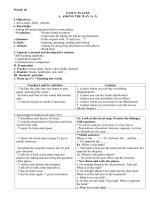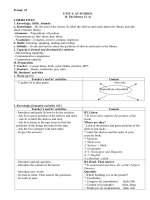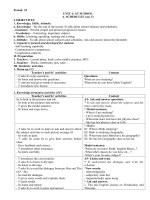unit 4 at school tiếng anh 7 sách cũ nguyễn văn liệt thư viện giáo án điện tử
Bạn đang xem bản rút gọn của tài liệu. Xem và tải ngay bản đầy đủ của tài liệu tại đây (121.47 KB, 5 trang )
<span class='text_page_counter'>(1)</span><div class='page_container' data-page=1>
<b>Period: 22</b>
<b>UNIT 4: AT SCHOOL</b>
<b>A. SCHEDULES (A4, 5)</b>
<b>I. OBJECTIVES </b>
<i><b>1. Knowledge, Skills, Attitude: </b></i>
<i><b>a. Knowledge: - By the end of the lesson, Ss talk about school subjects and schedules.</b></i>
<i><b>- Grammar: - Present simple and present progressive tenses.</b></i>
<i><b>- Vocabulary: - Interesting, important, subject.</b></i>
<b>b. Skills: Listening, speaking, reading and writing.</b>
<b>c. Attitude: - Ss talk about school subjects and schedules; Ask and answer about the timetable</b>
<i><b>2. Capacity is formed and developed for students</b></i>
- Self-learning capability.
- Communicative competence
- Cooperation capacity
<b>II. Preparation</b>
<i><b>1. Teacher: - Lesson plane, book, color chalks, pictures, MP3</b></i>
<i><b>2. Students: - Books, notebooks, pen, ruler …</b></i>
<b>III. Students’ activities</b>
<i><b>1. Warm up (5’)</b></i>
<b>Teacher’s and Ss’ activities</b> <b>Content</b>
- T asks Ss some questions.
- Ss listen and answer the questions.
- T corrects and gives marks if necessary.
- T introduces new lesson.
<b>Questions:</b>
What are you studying?
What time do you have Math/ English?
<i><b>2. Knowledge formation activities (36’)</b></i>
<b>Teacher’s and Ss’ activities</b> <b>Content</b>
Ss to look at the pictures and ask.
- Ss look at the pictures and answer.
- T gives the model sentence.
- Ss listen and copy down.
<b>A4- Ask and answer questions.</b>
<i>* Ss ask and answer about the subjects and the</i>
<i>times which they study.</i>
<b>* Model sentence:</b>
- What is Lan studying?
- Lan is studying physics.
- What time does Lan have her physics class?
- She has her physics class at 8.40.
- T asks Ss to work in pairs to ask and answer about
the subject and time in each picture on page 43.
- Ss work in pairs.
- T calls on some Ss to give their answers before
class.
- Give feedback and correct.
- T introduces other structures.
- Ss listen carefully.
<b>*. Keys:</b>
S1: What is Binh studying?
S2: Binh is studying Geography.
S1: What time does Binh have his geography?
S2: He has his Geography class at ten ten.
……
<b>Model sentence:</b>
-When do you have Math/ English/Music..?
-What other classes do you have on…?
-What’s your favorite subject?
- T introduces the conversation.
- T asks Ss to listen to the tape.
- Ss listen to the tape.
- T asks Ss to read the dialogue between Hoa and Thu
(A5 / 44).
- Ss read the dialogue.
- T gives some words and explains them.
- T reads model.
- Ss listen and repeat.
- T asks Ss to work in pairs and answer.
<b>A5- Listen and read.</b>
<i>* Ss understand the dialogue and write the</i>
<i>schedule.</i>
<b>*New words:</b>
- interesting(adj):
- subject(n): môn học
- important(adj): quan trọng
<b>* Ask and answer:</b>
</div>
<span class='text_page_counter'>(2)</span><div class='page_container' data-page=2>
- Ss practice asking and answering before class.
- SS practice.
- Give feedback.
2. Thu has math, geography, physical education
and music on Thursday.
3. History is Thu’s favorite subject. Because it is
interesting and important.
<i><b>3. Consolidation (4’)</b></i>
- T asks Ss to practice asking and answering about the time.(talk about their subjects).
- Ss work in pairs.
- T calls on some to practice before class.
- Give feedback and correct.
<b>IV. Experience:</b>
………
………
………
<b>Period: 23</b>
<b>UNIT 4: AT SCHOOL</b>
<b>A. SCHEDULES (A6)</b>
<b>I. OBJECTIVES </b>
<i><b>1. Knowledge, Skills, Attitude: </b></i>
<i><b>a. Knowledge: - By the end of the lesson, Ss ask and answer about the schedules and talk about the</b></i>
differences between schools in the USA and schools in Vietnam.
<i><b>- Grammar: Present simple tense.</b></i>
<i><b>- Vocabulary: Uniform, break, cafeteria, snack, popular, baseball.</b></i>
<b>b. Skills: Listening, speaking, reading and writing.</b>
<b>c. Attitude: - Ss ask and answer about the schedules and talk about the differences between schools in the </b>
USA and schools in Vietnam; Know about the American students’ life.
<i><b>2. Capacity is formed and developed for students</b></i>
- Self-learning capability.
- Communicative competence
- Cooperation capacity
<b>II. Preparation</b>
<i><b>1. Teacher: - Lesson plane, book, color chalks, pictures, MP3</b></i>
<i><b>2. Students: - Books, notebooks, pen, ruler …</b></i>
<b>III. Students’ activities</b>
<i><b>1. Warm up (5’)</b></i>
<b>Teacher’s and Ss’ activities</b> <b>Content</b>
- T asks Ss to play the game “Lucky number” or asks
the questions.
- Ss play the game or answer.
- T remarks and gives marks.
1. When do you have English?
2. What time does your first English class start?
3. Lucky number
4. Lucky number
5. What subjects do you like?
6. What time do your classes start?
7. Lucky number
8. What time do they finish?
<i><b>2. Knowledge formation activities (36’)</b></i>
<b>Teacher’s and Ss’ activities</b> <b>Content</b>
<b>*Pre teach vocabulary.</b>
- T introduces new lesson.
- T elicits some new words in the text,
explain them by translation, explanation, mime …
- T reads model.
- Ss listen and repeat.
<b>6. Read.</b>
<i>* Ss talk about the differences between schools</i>
<i>in the USA and schools in Vietnam.</i>
<b>* New words.</b>
</div>
<span class='text_page_counter'>(3)</span><div class='page_container' data-page=3>
- T checks pronunciation
- Ss listen and copy down their notebooks.
*True / False statement predictions.
- T gives a porter with statements on the board. - T
asks Ss to read all statements and predict which is
true, which is false.
- Give feedback.
- 20 minute break: giờ giải lao 20’
- cafeteria(n) : quán tự phục vụ
- snack (n) : món ăn nhanh, món ăn nhe
- popular (adj) : phổ biến
- baseball (n) : bóng chày
- sell(v): bán
<b>* True / False statements:</b>
a. Ss do not usually wear school uniform.
b. There are classes on Saturday morning
c. Ss don’t have a break in the afternoon.
d. The school cafeteria sells food to students
e. The school cafeteria only opens at lunchtime.
f. Basketball is an unpopular after-school
activity.
<b>* Reading and checking.</b>
- T asks Ss to listen to the text twice.
- T asks Ss to read the text silently.
- T asks Ss to check T or F.
- T calls on some Ss to give their answers. Then ask
Ss to correct the false statements.
- Give feedback and correct.
<b>* Keys:</b>
a. True
b. False (There are no lessons on Saturday)
c. False (Ss have a break in the afternoon)
d. True
e. False ( It also opens at break)
f. False (It is one of the most popular
after-school activities)..
- T asks Ss some questions.
- T calls on some Ss to give their answers.
- T remarks and summarize again.
<b>Questions:</b>
- How is school in USA different from school in
VN?
- What time do classes start?
- What time do classes end?
<i><b>3. Consolidation (4’)</b></i>
<i>- T asks: </i> <i>a. What do you wear to school?</i>
<i>b. What color is it?</i>
<i>c. How do you feel?</i>
<i>- Ss answer:</i>
<b>IV. Experience:</b>
………
………
………
<b>Period: 24</b>
<b>UNIT 4: AT SCHOOL</b>
<b>B. The library (1, 2)</b>
<b>I. OBJECTIVES </b>
<i><b>1. Knowledge, Skills, Attitude: </b></i>
<i><b>a. Knowledge: - By the end of the lesson, Ss ask and answer about the positions of shelves and racks in</b></i>
the library.
<i><b>- Grammar: - Wh - questions.</b></i>
- Demonstratives: this/ these; that/ those.
<i><b>- Vocabulary: - Rack, shelf, science book, chemistry, biology, dictionary, reader, novel, reference book, </b></i>
at the back of.
<b>b. Skills: Listening, speaking, reading and writing.</b>
<b>c. Attitude: - Ss ask and answer about the positions of shelves and racks in the library</b>
<i><b>2. Capacity is formed and developed for students</b></i>
</div>
<span class='text_page_counter'>(4)</span><div class='page_container' data-page=4>
<b>II. Preparation</b>
<i><b>1. Teacher: - Lesson plane, book, color chalks, pictures, MP3</b></i>
<i><b>2. Students: - Books, notebooks, pen, ruler …</b></i>
<b>III. Students’ activities</b>
<i><b>1. Warm up (5’)</b></i>
<b>Teacher’s and Ss’ activities</b> <b>Content</b>
- T writes the words with disordered letters on the
board (or use the poster).
- T divides the class into two teams.
- T asks Ss from each team to go to the board and
write the correct words. The team that is faster with
more correct words will win the game.
- l i o g o b y -> biology
- t o r i s h y -> history
- p h y g r a g e o -> geography
- s p a n w e e p r -> newspaper
- z a g a m i n e -> magazine
<i><b>2. Knowledge formation activities (36’)</b></i>
<b>Teacher’s and Ss’ activities</b> <b>Content</b>
- T shows the picture in the text book on page 47 and
introduces new lesson by asking some questions.
- Ss listen and answer the questions.
- T elicits some new words in the dialogue.
Explain them by picture, definition, realize, example,
…
- T reads model.
- Ss listen and repeat and copy down their book.
- Check pronunciation.
- T gives Ss two questions and asks them to guess the
answers.
- Give feedback.
<b>B1. Listen and read</b>
<i>* Ss know some position of the things.</i>
<b>* Questions:</b>
1. What is it?
2. Where do you usually see it?
3. Does your school have a library?
4. What time does it open / close?
<b>* New words:</b>
- library (n) : thư viện
- science book (n) : sách khoa học
- Chemistry (n) : môn hóa học
- Biology (n) : môn sinh học
- dictionary (n): từ điển
- reader (n): sách đọc thêm
- novel (n): tiểu thuyết
- Reference book (n): sách tham khảo
- At the back of: phía sau
- In the middle of: ở giữa
<b>* Questions:</b>
1. When does the library open?
2. What kinds of books are there in the library?
* Keys:
1. The library opens at 7 am.
2. There are newspapers, magazines, readers,
novels, dictionaries, reference books and many
kinds of science books …
- T asks Ss to read the dialogue B1 on page 47 and
check their answers.
- Give feedback.
- T asks Ss to read the questions on page 48 and work
in pairs to answer the questions.
- T calls some Ss to practice before class.
- Give feedback.
<b>* Answers:</b>
a. The magazines are on the racks.
b. The newspapers are on the racks.
c. The math and science books are on the shelves
on the left.
d. The history and geography books, dictionaries
and literature in Viet Nam are on the shelves on
the right.
e. The books in English are at the back of the
library.
f. It opens at 7 am.
g. It closes at 4.30.
- T introduces the dialogue and turns on the tape
(twice).
</div>
<span class='text_page_counter'>(5)</span><div class='page_container' data-page=5>
- Introduces prepositions of position and the
structure.
- Ss listen and write in their book.
- Ask Ss to practice the dialogue.
- Explain how to do the exercise.
- Ss work in pairs.
- Ss practice in front of class.
- T corrects
- Prepositions of position:
+ on the shelves, on the left, on the racks, in the
corner, on the right.
- Where can I find+ name of book, please?
Ex: where can I find Math books, please?
They are on the right.
* Ask and answer the questions about the library
plan in B1.
* Ss act out the dialogue in front of the class.
<i><b>3. Consolidation (4’)</b></i>
- Repeat names of many kinds of books in the library.
- Repeat preposition of position.
<b>IV. Experience:</b>
………
………
………
Signature
Week 8:
</div>
<!--links-->

